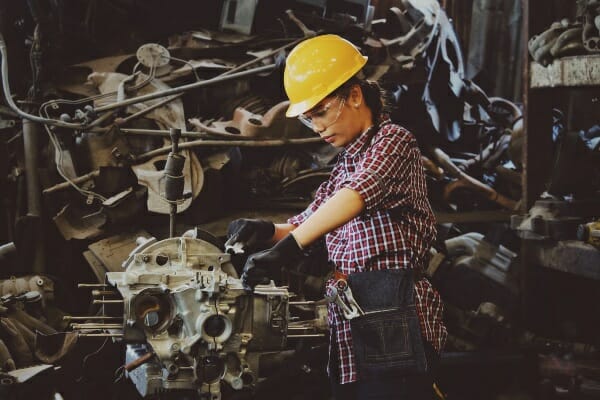March 18, 2022

Pinning is one of the most serious dangers in a workplace. Pinning accidents frequently cause death, loss of limbs, or other serious injuries. Employers have a legal obligation to take steps to protect workers from pinning dangers.
Protect Workers from Pinning Dangers
Employers have a duty to protect their workers from dangers on the job. While it’s true that some jobs, such as construction, are dangerous because of the nature of the work, many accidents are caused by human error or failure to take appropriate safety precautions. Employers have an obligation to provide the right tools, equipment, training, staffing, and procedures to prevent accidents from happening.
When an accident happens at work, there are often one or more reasons why the employer is liable. People frequently make mistakes or skip procedures to make a job go more quickly. The employer is ultimately responsible for the safety of a job site.
Protecting Workers from Getting Pinned
OSHA requires that employers take a number of precautions to protect workers from getting pinned.
- Provide guards on power tools and equipment with moving parts. This protects workers from getting pulled or falling into machinery.
- Secure equipment not in use or down for maintenance. Any equipment that’s not in use should be secured to prevent pinning. For example, a bulldozer should be fully lowered when parked to keep it from falling on someone in case of mechanical failure or being struck by something else. If workers need to enter or work under machinery during repairs, that machinery should be similarly secured to prevent unexpected movements.
- Take measures to avoid pinning in tipping accidents. Heavy equipment, such as cranes, should be counterweighted to prevent tipping. Workers who are operating equipment should be protected by seatbelts, rollbars, or other devices to keep them in a protected area in an accident.
- Prevent workers from being trapped between equipment and solid objects. This can range from not allowing personnel to walk between the equipment and a wall to adding bracing or other physical barriers.
- Provide appropriate precautions during excavations. Any excavations must be done in a safe manner to avoid collapses, including proper sloping, shoring of walls, and placement of equipment. Excavation work must be supervised by someone trained to inspect trenching operations and who is familiar with the type of soil being worked on.
- Properly support all scaffolding. Scaffolds should be built to prevent collapse even in unexpected conditions. A competent person must supervise all work to erect, move, dismantle, or alter any scaffolding.
- Secure walls against collapse. Whether during demolition or construction, all walls must be properly braced to avoid collapse. This includes adding temporary bracing if the wall’s permanent structure is not in place or is to be demolished.
- Properly train and hire. The employer must select supervisors with the appropriate skills and experience to supervise all work and ensure safety. All workers of all levels must be trained to safely perform their jobs and to prevent injuries to others.
Pinning Injuries at Work
Pinning injuries are also known as caught-in or caught-between hazards. A worker might get caught in a piece of machinery that didn’t have proper guards on it to prevent a worker from being pulled in and pinned between moving parts. A worker might be caught between a piece of machinery and a fixed object or another piece of machinery. Pinning injuries also include workers who get trapped under dirt or other materials that collapse unexpectedly.
Common pinning injuries can include the following accidents.
- Loss of a finger caught in a saw
- Being pulled into a piece of machinery due to a loose piece of clothing contacting moving parts
- Becoming trapped in moving equipment that should have remained off while the worker was cleaning or repairing it
- Being buried when a trench collapses during excavation work
- Having a vehicle overturn while working on uneven terrain
- A machine operator accidentally or negligently moving heavy equipment while another worker is in the danger zone
- Materials or equipment shifting or collapsing while being loaded or unloaded.
Worker Getting Pinned
A worker getting pinned requires an urgent response from the employer. A proper response can reduce and possibly even totally prevent injuries. If a worker is pinned, all work must stop except any work needed to secure the area. Involved machinery or equipment should be immediately disabled. When possible, automatic shutoffs with safety triggers should be used. Workers should be trained in rescue procedures, such as how to safely dig someone out of a collapse or stabilize involved machinery. There should also be someone in charge of calling 911 and any other applicable emergency response services.
An employer’s responsibility to their workers includes having response plans, training workers on those response plans, and making sure workers have what they need to appropriately respond to emergencies. Employers should also complete detailed accident reports and notify workers’ compensation, their insurance company, or any other regulatory agencies as appropriate. Any failure to prevent, properly respond to, or report a pinning accident may increase an employer’s liability.
Get Help from an Experienced Work Injury Lawyer
If you’ve been injured in a pinning accident or believe you’re at risk due to an unsafe workplace, an experienced work injury lawyer may be able to get you the compensation and safety changes you and your workers deserve. To speak with an experienced work injury lawyer, call Waldman Legal now at (713) 688-4878.

